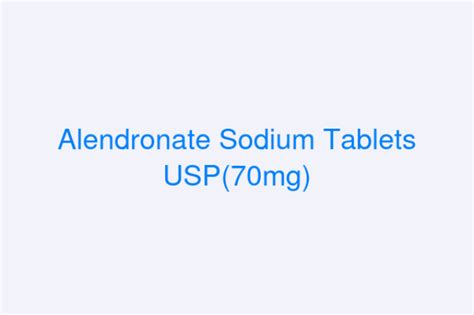For individuals concerned about bone health, particularly those with osteoporosis, alendronate sodium 70mg is a commonly prescribed medication. This bisphosphonate drug works by reducing bone resorption, thus slowing bone loss and potentially increasing bone density. The effectiveness of alendronate sodium 70mg can be evaluated by its ability to prevent fractures, improve bone mineral density (BMD), and its impact on the quality of life for patients with osteoporosis.
Mechanism of Action
Alendronate sodium primarily acts on the bone tissue. It inhibits osteoclast-mediated bone resorption, which is the process by which bones are broken down. By reducing bone resorption, alendronate sodium allows the bones to retain more of their density, which is crucial for preventing fractures and supporting the body’s structure.
Clinical Evidence and Efficacy
Numerous clinical trials have demonstrated the efficacy of alendronate sodium in treating osteoporosis. The Fracture Intervention Trial (FIT), for example, showed that alendronate significantly reduced the risk of vertebral fractures by about 50% over a period of four years in postmenopausal women with osteoporosis. For non-vertebral fractures, the reduction in risk was more modest but still significant, around 30-40%. The efficacy of alendronate in improving BMD has also been consistently shown across various studies, with increases in lumbar spine and hip BMD observed after treatment.
Safety Profile
While effective, alendronate sodium is not without potential side effects. Common adverse effects include gastrointestinal disturbances such as nausea, abdominal pain, and esophageal irritation. More severe side effects, although rare, can include osteonecrosis of the jaw and atypical fractures of the femur. The risk of these severe side effects is generally low but highlights the importance of careful patient selection and monitoring.
Dosage and Administration
Alendronate sodium is typically administered in a 70mg tablet once weekly. The choice of this dosage regimen is to enhance patient compliance by reducing the frequency of administration while maintaining therapeutic efficacy. Proper administration is crucial to minimize the risk of esophageal irritation; patients are instructed to take the tablet with a full glass of water, stay upright for at least 30 minutes, and not to lie down until after their first food of the day.
Comparison with Other Treatments
In the context of osteoporosis treatment, alendronate sodium is one of several bisphosphonate options. Other medications in this class include risedronate, ibandronate, and zoledronic acid. Each has its own profile of efficacy, safety, and convenience, making the choice among them dependent on individual patient factors and preferences. For some patients, particularly those with severe osteoporosis or who have not responded adequately to bisphosphonates, alternative treatments such as denosumab (a RANKL inhibitor), teriparatide (a parathyroid hormone analogue), or romosozumab (a sclerostin inhibitor) might be considered.
Impact on Quality of Life
The effectiveness of alendronate sodium extends beyond the prevention of fractures and improvement in BMD. By reducing the risk of osteoporotic fractures, it significantly impacts patients’ quality of life. Fractures, particularly vertebral fractures, can result in chronic pain, loss of height, stooping, and a decrease in mobility and independence. Preventing these outcomes can help patients maintain their functional status and reduce the need for surgical interventions or long-term care.
Conclusion
In conclusion, alendronate sodium 70mg is an effective treatment for osteoporosis, offering significant benefits in preventing fractures, improving bone mineral density, and maintaining quality of life for affected individuals. While it is associated with potential side effects, the overall safety profile supports its use when properly prescribed and monitored. As part of a comprehensive approach to bone health that includes lifestyle modifications, dietary adjustments, and possibly other pharmacological interventions, alendronate sodium plays a critical role in managing osteoporosis and reducing the risk of debilitating fractures.
Frequently Asked Questions
What is the primary mechanism of action of alendronate sodium?
+Alendronate sodium primarily acts by inhibiting osteoclast-mediated bone resorption, which helps in reducing bone loss and increasing bone density.
What are the common side effects of alendronate sodium?
+Common side effects include gastrointestinal disturbances like nausea, abdominal pain, and esophageal irritation. Severe but rare side effects can include osteonecrosis of the jaw and atypical femoral fractures.
How is alendronate sodium administered, and what are the administration guidelines?
+Alendronate sodium is typically administered once weekly as a 70mg tablet. Patients are instructed to take the tablet with a full glass of water, stay upright for at least 30 minutes, and not to lie down until after their first food of the day to minimize the risk of esophageal irritation.
How does alendronate sodium compare to other osteoporosis treatments?
+Alendronate sodium is one of several bisphosphonate options. The choice among bisphosphonates or alternative treatments like denosumab, teriparatide, or romosozumab depends on individual patient factors and preferences.



